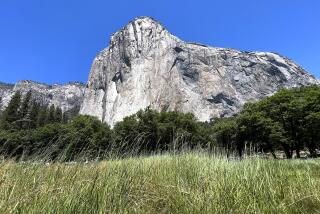National Parks: Coming Alive
- Share via
As predicted, William Penn Mott has brought welcome new energy and ideas to the National Park Service in the two short months during which he has been U.S. parks chief. Mott has his priorities in order, and his first is to provide adequate protection for the parks most threatened by encroaching civilization and overuse.
The most notorious crowding problems occur during Memorial Day-to-Labor Day holiday periods at Yosemite National Park in California. The problem is easy to define: too many automobiles. The solution is tougher, but it obviously involves a reduction in the traffic jamming the seven-mile-long Yosemite Valley.
The current idea of closing the gates after a quota of cars has entered the park is the most obvious temporary solution, and the Park Service has pledged to do this. We’re not wild about Mott’s idea of limiting visits by Californians so that those who travel much longer distances can enjoy Yosemite. But there is no perfectly equitable solution. Clearly, more Californians could visit Yosemite during the spring and fall--probably the most delightful seasons there.
At some point the Park Service must invest in an expanded transit system that can transport visitors from the entrance at El Portal to the valley with efficiency--perhaps even carrying their bikes or canoes as well as luggage, backpacks and other gear. Once within the valley, there is really no need for an auto.
Happily, another of Mott’s goals may be simpler to achieve: creation of a Tall Grass Prairie Preserve in northern Oklahoma. The Park Service, private groups like the Nature Conservancy and Oklahoma residents are coming together in a plan to protect up to 60,000 acres of virgin native grassland such as the pioneers crossed by wagon in the 19th Century. Sen. Don Nickles (R-Okla.) deserves strong support for his Oklahoma prairie-grass legislation.
More difficult, but also worthy, is Mott’s concept of incorporating an entire river system into the National Park System. The Yellowstone has been mentioned, and it would be an outstanding candidate with a variety of historic, cultural and natural attributes.
Closer to home, we hope that Mott will consider and quickly drop his suggestion--perhaps he was merely thinking out loud--that the federal government incorporate the state redwood preserves into the Redwood National Park and, in exchange, have the state take over the Santa Monica Mountains National Recreation Area.
The redwood parks should be fully integrated, but Congress made a deliberate decision that the Santa Monica Mountains deserved the full protection of congressional edict and required the financial might of the federal government to purchase critical lands. The Santa Monica Mountains should remain solidly in the national park system, and should be high on the list when the Administration and Congress resume park purchases.
Considerably more energy and political skill will be required to actually implement Mott’s ideas. With luck, Congress will find his enthusiasm for the parks contagious, and resume with vigor the job of building the park system. It is, after all, a task that must never end.
More to Read
Sign up for The Wild
We’ll help you find the best places to hike, bike and run, as well as the perfect silent spots for meditation and yoga.
You may occasionally receive promotional content from the Los Angeles Times.






